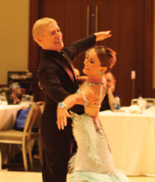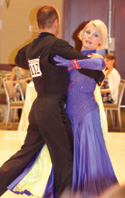Competition
Competitive and Social
All dances can be danced for the simple social pleasure of people moving to music together, or can be taken to the level of competitive dancing, where the partners are no longer striving just to have fun, but rather to meet a high standard of technical and artistic goals.
Dance Competitions are a wonderful way to enjoy your new dancing skills, and can provide a focus for your Private Lessons and dancing enjoyment. Competitions are set up so everyone can participate, from beginners with just several months’ experience to professionals. Most students do not have a partner; instead they dance with their teacher.
How many of you have seen Championship Ballroom Dancing on PBS? There are many competitions all over the United States including several in and near Chicago. They are set up so that even beginners can participate. In the Newcomers Category you only need to have taken classes for as few as 2 or 3 months. Try it!
 Are you worried that you don’t have a partner?
Are you worried that you don’t have a partner?
Most students don’t, and you can dance with your instructor at the competitions.
What is a competition?
A dance competition is an organized dance event that invites people of all ages and levels to participate in the sport of Ballroom and Latin dancing. It is usually held at a hotel so dancers from all over the country and even the world can participate. It is typically a two or three day event from morning until midnight and consists of competitions, shows and general dancing.
As a spectator it allows you the opportunity to see dancing at all levels from beginner through professionals and watch live some of the finest Ballroom and Latin dancing in the world today.
Why should I dance at a competition?
Dancing at a competition has many benefits for the dance student. Primarily it creates a clear goal for you and your dancing. By having a date to shoot for you will find that you get more value out of your classes. Students who do competitions tend to learn faster and dance with more technique and style than students who take classes for social dancing only. The day of the competition is lots of fun. There is a lot of camaraderie amongst all the dancers and by the end of the weekend most people feel a sense of accomplishment and are inspired to learn more and more.
 What if I’m just a beginner?
What if I’m just a beginner?
The competitions are set up to include dancers at all levels. The newcomer division is designed for students who have been dancing for just a few months.
But I don’t like competition.
Most people who participate in dance competitions are not in it for winning. The way we approach it is more like you are competing against yourself. It is an opportunity to set a goal, work hard, then go out and do it.
Who do I dance with and what is the format?
If you have a partner you may dance together. Most people, however, do not have partners in the early stages of learning, and most dance with their teachers. This is called Pro-Am or Student-Teacher.
You may dance a solo routine which is a choreographed dance done to a specific piece of music with an entrance and an exit. You are on the floor by yourself and will receive a written critique and a score from the judges. You will also receive a trophy or a plaque.
The other category is group competitions (or freestyles) where you and your teacher (partner) are on the dance floor with other couples at your same level. You will receive a placing 1st, 2nd, 3rd etc. as well as a plaque or a trophy.
 Dance competition styles:
Dance competition styles:
Competition styles:
There are two recognized Ballroom styles in the world – International and American Social. Both styles are danced socially and competitively. The International Style is danced worldwide, including North America, to a strict syllabus that originated in the European dance competitions of the early 1900s. Although both styles can be danced socially, the American style is generally easier to learn and practice with different partners.
It is easier for beginning dancers to practice on crowded dance floors. We often advise novice dancers to try the American style first. It’s the style of dance they would most probably see at a local social event. In both the American and International competitive styles, the difficulty of steps is categorized by a medal category, with Bronze being basic, Silver being intermediate and Gold being advanced. Silver means that the step patterns used in these classes are drawn from the Silver level of steps in the syllabus (the syllabus is a list of steps appropriate to each metal level).
There are some key differences between American Smooth and International Standard. American Smooth allows for more freedom of expression. It may be danced in closed or open position, and it allows for additional innovative tricks and creative arm and head styling. International Style is danced only in closed position.Technique for both styles is the same. When international couples do shows they frequently do long sections of American style in addition to lift work.
There are also some key differences between American Rhythm and International Latin. In American Style Rhythm there are a greater variety of patterns and it is more suited for social dancing. International Style Latin is more disciplined and technical.
NOBODY PUTS BABY IN THE CORNER!
Are you ready to make a move?
